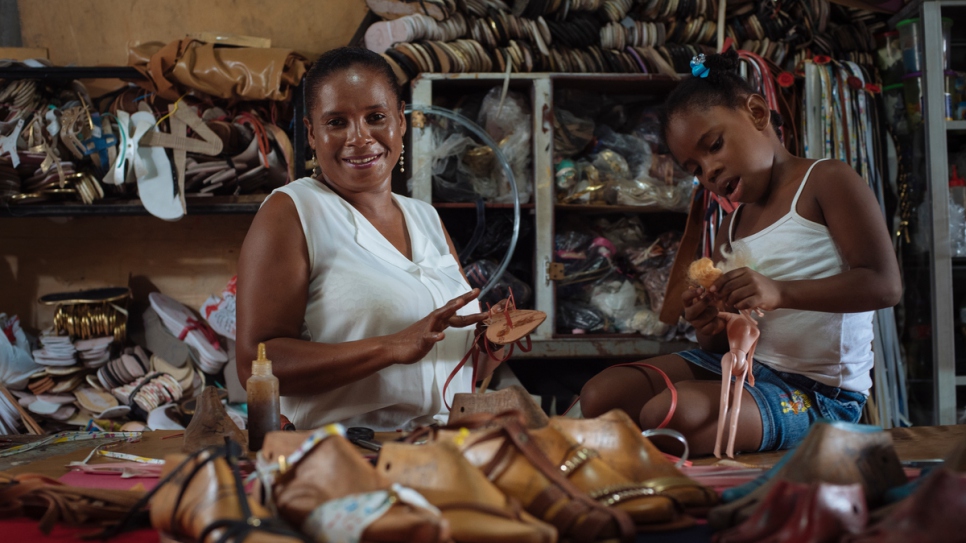In 2016’s historic New York Declaration for Refugees and Migrants, all 193 Member States of the United Nations agreed that protecting those who are forced to flee and supporting the countries that shelter them are shared international responsibilities that must be borne more equitably and predictably.
The Declaration gave UNHCR the task of building upon the Comprehensive Refugee Response Framework (CRRF), contained in Annex I of the New York Declaration, to develop a ‘global compact on refugees’. UNHCR has been engaged in consultations with governments and other stakeholders to develop the compact, and the High Commissioner will propose the text of the global compact on refugees in his 2018 annual report to the General Assembly.
The global compact on refugees is a unique opportunity to strengthen the international response to large movements of refugees and protracted refugee situations. Its four key objectives are to:
- Ease the pressures on host countries;
- Enhance refugee self-reliance;
- Expand access to third-country solutions;
- Support conditions in countries of origin for return in safety and dignity.
The New York Declaration has also set in motion a separate, ongoing process for the negotiation of the global compact for safe, regular and orderly migration, to which UNHCR is actively contributing.
What will the global compact on refugees include?
As outlined in UNHCR’s ‘roadmap’, the global compact on refugees will have two parts:
- The Comprehensive Refugee Response Framework (CRRF), as agreed to by Member States in the New York Declaration.
- A programme of action that builds on the CRRF and sets out measures for States and other relevant stakeholders to better share responsibility and cooperate more effectively in the response to large-scale movements of refugees and protracted situations. The programme of action provides a blueprint to support host countries and communities to ensure, for example, that refugees have better access to health, education and livelihood opportunities and are included in their host communities from the very beginning.
How will the global compact on refugees be developed?
In 2017, three interrelated processes contributed to the development of the global compact on refugees:
- The Comprehensive Refugee Response Framework (CRRF) was applied in more than a dozen countries and a process of collecting good practices and lessons learned was undertaken, including by drawing lessons from a wide range of existing and past refugee situations where many of the Framework’s principles already inform policies and programmes. This process will continue in 2018.
- Thematic discussions on the key aspects of the global compact on refugees took place in the second half of 2017 and involved the participation of UN Member States, NGOs, academics, experts, advocacy groups, and other stakeholders. Key topics were addressed in these discussions, with a focus on how the international community can support countries and communities to receive and host large numbers of refugees.
- The High Commissioner’s Dialogue on Protection Challenges in December 2017 was used to take stock of progress made and lessons learned in the course of the practical application of the CRRF and the thematic discussions.
In 2018, formal consultations are taking place between February and July to discuss the iterative draft texts of the global compact on refugees. Following this process, the text of the compact will be proposed by the High Commissioner for Refugees in his 2018 annual report to the United Nations General Assembly.
UNHCR is also encouraging United Nations Member States and all other stakeholders to submit written contributions to UNHCR for posting.
Further information on this process can be found in Towards a global compact on refugees: a roadmap.
Additional resources
- Towards a global compact on refugees: a roadmap
- Towards a global compact on refugees: key elements of the roadmap
- ‘A new deal for refugees’: stories exploring the many facets of the global compact on refugees
- Thematic discussions for the global compact on refugees
- Formal consultations on the global compact on refugees
- Written contributions to the process leading to the global compact on refugees
- Quick Guide on New York Declaration for Refugees and Migrants
- The New York Declaration for Refugees and Migrants: Answers to Frequently Asked Questions
- Bringing the New York Declaration to Life: Applying the Comprehensive Refugee Response Framework
- Text of the New York Declaration
- ‘UN refugee head says global compact is chance to chart a different course’
- A Minor Miracle: A New Global Compact on Refugees, address by Volker Türk, Assistant High Commissioner for Protection

